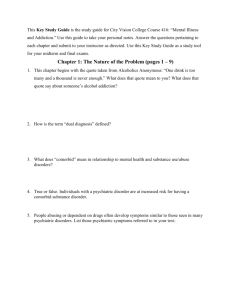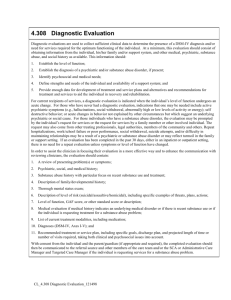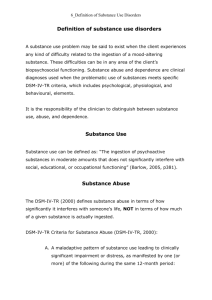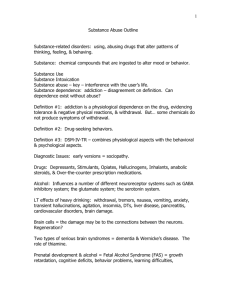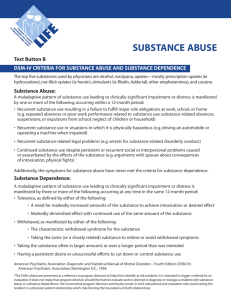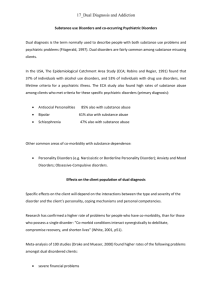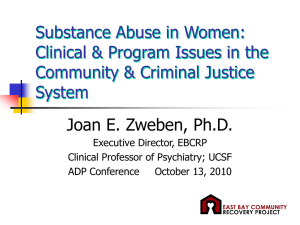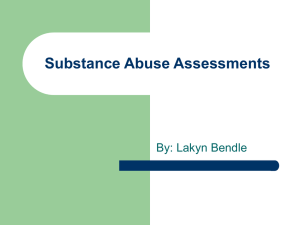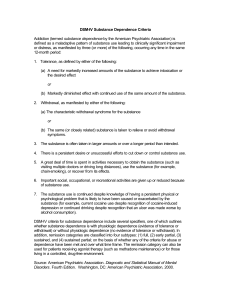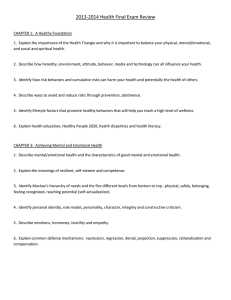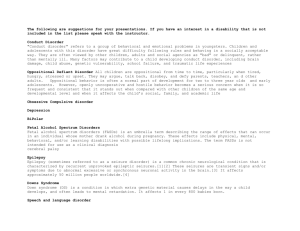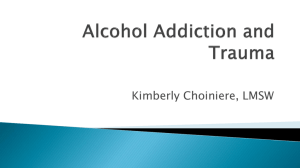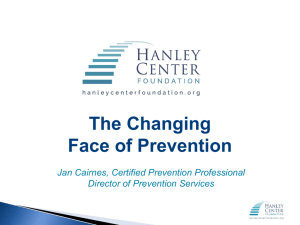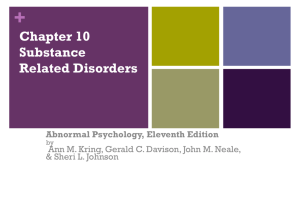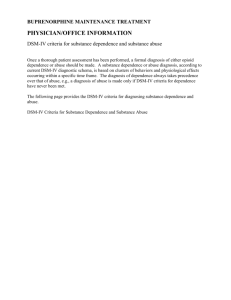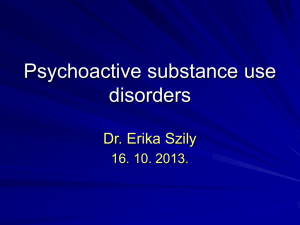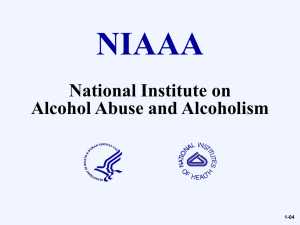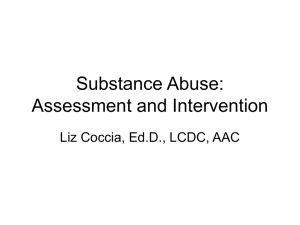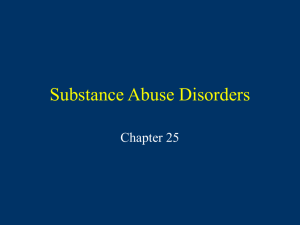Alcohol Abuse and Dependence
advertisement
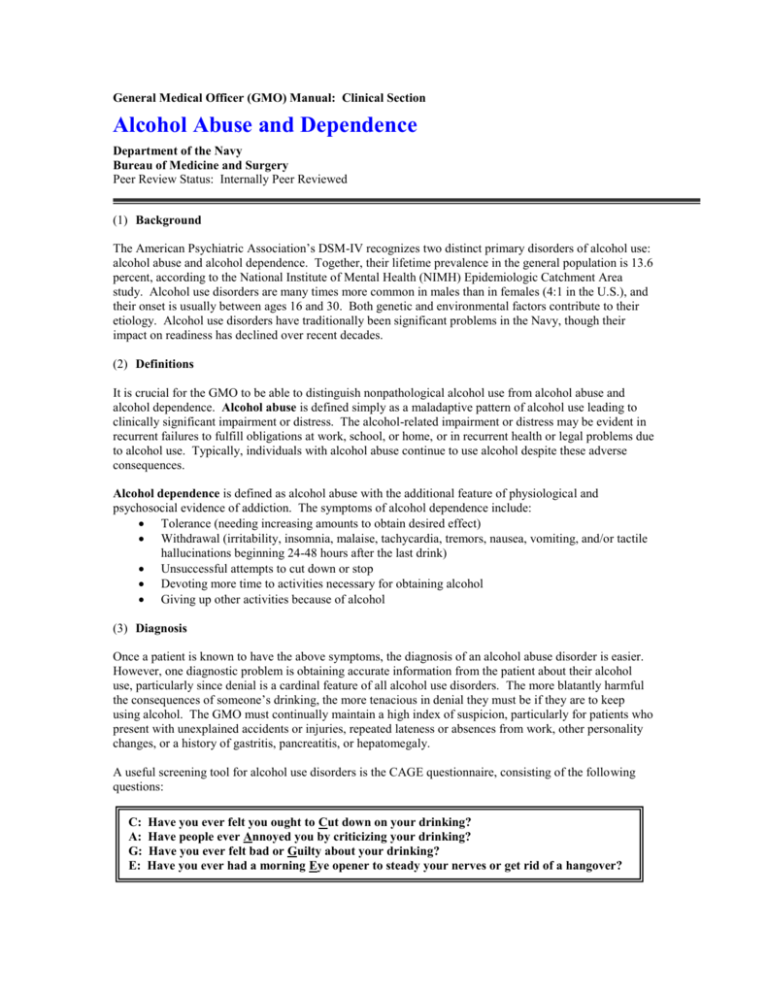
General Medical Officer (GMO) Manual: Clinical Section Alcohol Abuse and Dependence Department of the Navy Bureau of Medicine and Surgery Peer Review Status: Internally Peer Reviewed (1) Background The American Psychiatric Association’s DSM-IV recognizes two distinct primary disorders of alcohol use: alcohol abuse and alcohol dependence. Together, their lifetime prevalence in the general population is 13.6 percent, according to the National Institute of Mental Health (NIMH) Epidemiologic Catchment Area study. Alcohol use disorders are many times more common in males than in females (4:1 in the U.S.), and their onset is usually between ages 16 and 30. Both genetic and environmental factors contribute to their etiology. Alcohol use disorders have traditionally been significant problems in the Navy, though their impact on readiness has declined over recent decades. (2) Definitions It is crucial for the GMO to be able to distinguish nonpathological alcohol use from alcohol abuse and alcohol dependence. Alcohol abuse is defined simply as a maladaptive pattern of alcohol use leading to clinically significant impairment or distress. The alcohol-related impairment or distress may be evident in recurrent failures to fulfill obligations at work, school, or home, or in recurrent health or legal problems due to alcohol use. Typically, individuals with alcohol abuse continue to use alcohol despite these adverse consequences. Alcohol dependence is defined as alcohol abuse with the additional feature of physiological and psychosocial evidence of addiction. The symptoms of alcohol dependence include: Tolerance (needing increasing amounts to obtain desired effect) Withdrawal (irritability, insomnia, malaise, tachycardia, tremors, nausea, vomiting, and/or tactile hallucinations beginning 24-48 hours after the last drink) Unsuccessful attempts to cut down or stop Devoting more time to activities necessary for obtaining alcohol Giving up other activities because of alcohol (3) Diagnosis Once a patient is known to have the above symptoms, the diagnosis of an alcohol abuse disorder is easier. However, one diagnostic problem is obtaining accurate information from the patient about their alcohol use, particularly since denial is a cardinal feature of all alcohol use disorders. The more blatantly harmful the consequences of someone’s drinking, the more tenacious in denial they must be if they are to keep using alcohol. The GMO must continually maintain a high index of suspicion, particularly for patients who present with unexplained accidents or injuries, repeated lateness or absences from work, other personality changes, or a history of gastritis, pancreatitis, or hepatomegaly. A useful screening tool for alcohol use disorders is the CAGE questionnaire, consisting of the following questions: C: A: G: E: Have you ever felt you ought to Cut down on your drinking? Have people ever Annoyed you by criticizing your drinking? Have you ever felt bad or Guilty about your drinking? Have you ever had a morning Eye opener to steady your nerves or get rid of a hangover? (4) Physical Signs and Laboratory Studies Note the absence or presence of an alcohol odor on the breath, ataxia, red nose or palms, spider nevi, jaundice, poor dental care, abdominal tenderness, signs of portal hypertension, or loss of peripheral sensation or motor power. In addition to the blood alcohol level (>200 mg/dl is suggestive), macrocytosis, elevated transaminases (especially SGGT), and elevated uric acid and triglycerides may be found (but usually only in severe and chronic cases). (5) Treatment If an alcoholic patient presents in coma, protect the airway and give the standard oxygen, thiamine, glucose, and Narcan. Consider gastric lavage if other drug ingestion is suspected. For patients who are abusive or violent, use physical or chemical restraints as necessary. Significant alcohol withdrawal symptoms should be treated with thiamine and a benzodiazepine. Admit patients who are dangerously intoxicated, those with a history of serious withdrawal symptoms in the past, those with unstable medical complications, and those who are suicidal. (6) Further evaluation and aftercare Once medically stable, all active duty patients suspected of having an alcohol use disorder should be referred to their command DAPA or CAAC for further evaluation. Depending on the nature and severity of the disorder, the member may then be afforded treatment ranging from brief educational classes (Level 1) to domiciliary rehabilitation (Level 3). Abstinence from alcohol use and attendance at AA meetings will be recommended. Refusal to participate in treatment for an alcohol use disorder is grounds for administrative separation. (7) Final notes As the service member’s primary physician, you retain an important role throughout his or her evaluation, treatment, and aftercare. Maintain active liaison between the member’s command and treatment facilities. Steadfastly encourage abstinence and compliance with treatment recommendations, but don’t yield to temptations to be judgmental. Remember that alcohol use disorders are chronic and that recovery is a long and difficult road. Reference (a) The American Psychiatric Press Synopsis of Psychiatry, edited by Robert Hales and Stuart Yudofsky, published by American Psychiatric Press, Washington, DC, 1996. Revised by CAPT William P. Nash, MC, USN, Psychiatry Specialty Leader, Naval Medical Center San Diego, (1998).
